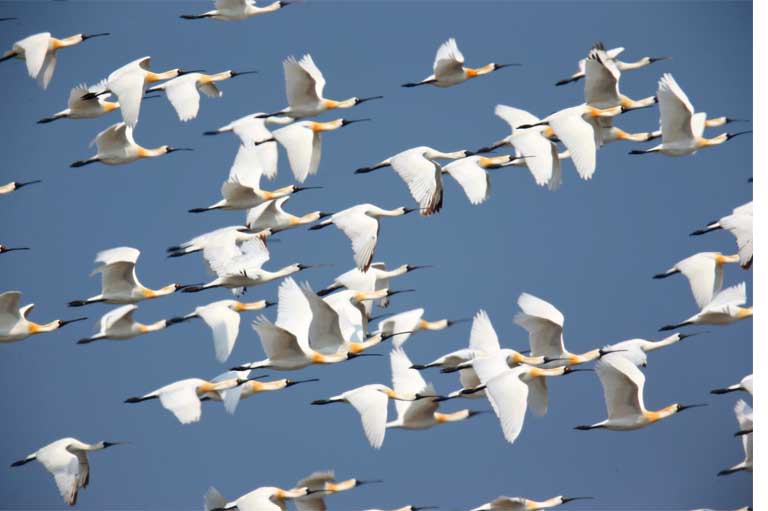- The Black-faced Spoonbill, with its fascinating feeding behaviors, has won the hearts of birders and the Asian public, making it a signature umbrella species for establishing coastal preserves that protect many other less charismatic bird species.
- The long-term conservation of this migratory species will require a commitment to protecting summer nesting grounds and winter roosting grounds, plus resting areas along the coasts of Korea, China, Taiwan, Japan, Vietnam, Thailand and the Philippines.
- Rapid population growth and coastal development for homes, recreation, industry, aquaculture and agriculture are the major threat to the species, and their preservation depends on ongoing human attention and intervention.

As autumn descends on the Korean Peninsula, Black-faced Spoonbills depart from nesting sites sheltered within one of the world’s most heavily armed borders. The Demilitarized Zone separating North and South Korea is off-limits to human incursion — and has been since the end of the Korean War in 1953. In turn, that 4 kilometer (2.5 mile) wide no man’s land has become a safe haven for the Endangered bird.
Korea’s lingering Cold War stalemate at the DMZ has prevented coastal development from encroaching on crucial Black-faced Spoonbill nesting sites. Spoonbill population data from North Korea is limited — not surprising considering the two belligerent armies facing off across the DMZ, or considering North Korea’s closed society. But experts say that the DMZ remains the bird’s biggest breeding ground.
Meanwhile, other important nesting habitat in northeast China — rocky outcrops from Bohai Bay to the Bay of Liaoning — are threatened, as are other wetlands critical to these transient birds in South Korea, mainland China and elsewhere in Southeast Asia — all areas under tremendous development pressures.
A bird beloved in the midst of geopolitical conflict
Black-faced Spoonbills (Platalea minor) wavered on the brink of extinction as recently as the 1980s. Scientists estimated that the population then had dropped as low as 288 birds. Today, the species remains Endangered. But their numbers have climbed steadily over the years. The results of the 2015 International Black-faced Spoonbill Census tallied the total population at more than 3,000 individuals for the first time.

Platalea minor owes much of its promising population gains to a concerted global conservation effort spanning some of the world’s most persistent, sometimes heated, geo-political disputes — arising between the two Koreas, China and Taiwan, and China and Japan. The species has even been spotted nesting on Russia’s Asian coast during the past decade.
Over the decades, the long-legged, fat-bodied birds have wobbled, waddled and soared from protected wetlands into the hearts of birdwatchers and general public alike.
The Black-faced Spoonbill’s migration route, the most restricted of the world’s six spoonbill species, traces the northern half of the East Asian-Australasian Flyway. The birds breed between March and September on small islands along the western coast of the Korean Peninsula, along China’s Liaoning Province and into Russia. In winter, the species migrates southward to wintering grounds that include coastal China, Japan, South Korea, Taiwan, Hong Kong, Macau, Vietnam, Thailand and the Philippines. Platalea minor is the only spoonbill species deemed Endangered by the IUCN Red List.
The birds use their signature flattened spatulate bills to methodically sweep low-lying bays, ponds and wetlands (hence the name “spoonbills”). They swing their rather goofy-looking heads through the water, rapidly back and forth, until they catch a fish or crustacean — movements many birders find fascinating. Then, they excitedly tilt their gullets back to chug their catch. Gulp! Coordinated formations of spoonbill groups herd prey across shallow tidal waters to help one another in their feasting.
These feeding antics attract photographers to nesting sites and staging grounds in China and South Korea. The birds are also a winter delight for avid birdwatchers in Taiwan and Hong Kong. Sixty-two percent of global populations of Black-faced Spoonbills wintered in Taiwan in 2015, and 13 percent wintered in Deep Bay, which separates northwestern Hong Kong from mainland China.
Conserving spoonbills in Hong Kong preserves other birds too
Crowded Hong Kong with its 7.2 million population isn’t a locale people generally think of as a conservation site. But its Mai Po Nature Reserve in Deep Bay consists of abandoned gei wai ponds, inaccessible mangroves, sprawling tidal mudflats, and bird blinds with limited public access. As a result, the reserve’s lush forests and other habitats teem with birds, which ignore Shenzhen’s skyscrapers beyond the bay on the horizon.

The Deep Bay area is an important stopping point for some 120,000 passing waterbirds each year, including the critically endangered Spoon-billed Sandpiper (Calidris pygmaea) — no relation to the spoonbill — now on the verge of extinction.
Bena Smith manages the Mai Po wetlands for the World Wildlife Fund’s Hong Kong office. He praised the spoonbill’s role as an umbrella species capable of generating public conservation interest.
“It’s very hard to get people emotional about a little bird,” said Bena Smith, referring to the Spoon-billed Sandpiper and other threatened and endangered birds that pass through Mai Po. “But the [Black-faced] Spoonbill is a big bird; it’s charismatic and fun to watch. A lot of these small birds out in the mud flat, you can’t even find, but this bird is very easy to see.”

Smith feels encouraged that the spoonbill’s story, thus far, breaks the “doom and gloom” pattern typically associated with endangered animals and their conservation. “Now you can point to the Black-faced Spoonbill and say, this is what can be done! So a good showcase,” he said.
The Black-faced Spoonbill proved instrumental in getting Mai Po and adjacent portions of Deep Bay designated as a Ramsar site — wetlands recognized as having international significance under the Ramsar Convention, an international treaty. But development pressures continue along Deep Bay’s periphery despite those protections.
Similar pressures plague other Ramsar sites designated, at least in part, to aid the plight of the Black-faced Spoonbill. Those Ramsar sites include Vietnam’s Xuan Thuy Natural Wetland Reserve; China’s Dongzhaigang, Yancheng National Nature Reserve, Chongming Dongtan Nature Reserve, Shankou Mangrove Nature Reserve; Japan’s Manko; and South Korea’s Suncheon Bay and Songdo.

Many of the spoonbill’s staunchest supporters remain worried about its long-term prospects, even Yu Yat-tung, the Research Manager at the Hong Kong Bird Watching Society. He produces the annual International Black-faced Spoonbill Census. Despite having tallied a record 3,272 birds in 2015, Yu said he is pessimistic for the future.
“Black-faced Spoonbills seem to be doing good in recent years, but we actually need to remind people that the bird is still not totally safe,” Yu said. Land reclamation along the Yellow Sea and South China Sea is one of his greatest concerns.
Supporting the growing population is another problem. The birds gather in large groups, so growing populations likewise require more expansive swaths of wetlands along with sufficient food sources.

“Except [for] Taiwan and Hong Kong, I cannot see many other sites that have a good management plan for wetlands and nature reserves in response to the conservation of Black-faced Spoonbills,” he said. “As the population is going up, we will need more places to hold these birds.”
Much remains unknown about the species. “The wintering population in Deep Bay actually had a decline from the peak number of 462 in 2010 to a low number of 252 in 2014 — before bouncing back up to 411 birds in January of 2015. What I am worrying [about] is that we have no idea of the reason for this decline,” Yu said. “We can only guess.”
Disease is one possible culprit for the 2014 decline. Avian botulism has killed a small number of birds in Hong Kong in recent years; it more notably killed 73 birds at Tainan, Taiwan in 2002.
Taiwanese research and conservation
Taiwan is home to numerous NGOs concerned with Black-faced Spoonbills. The most dedicated is the Taiwan Black-faced Spoonbill Conservation Association (TBSCA), founded in 1998.
“Most of our members are local people, including fish farmers, workers, teachers, and others. Our major works are long-term research of BFSs [Black-faced Spoonbills], birds, wetland ecosystems and local education in Taiwan,” said Dr. Tai Tzu-yao secretary-general of the TBSCA.
In 2007, the group launched an online platform to collect observations of the birds, the “Black-faced Spoonbill Conservation Network.” Last year, they also began a wetland restoration project in an unused pond. “We hope it will become an important foraging and resting habitat to support some of the wintering Black-faced Spoonbills in Tainan,” Dr. Tai said.

Despite strong Taiwanese national attachment to the birds, trouble has arisen in paradise — in an unusual form. Wu Shih-hung, the association’s volunteer website administrator, said that ultra-light aircraft pilots are flying illegally over some protected wintering habitats, disturbing the birds. “It is illegal and terrifies them, but our government does nothing about it,” Wu said.
From Deep Bay northward, people foraging for shellfish also often disturb the birds on tidal mudflats. Local fishermen have poached Platalea minor eggs from northern nesting sites as well. Even well intentioned photographers can pose a danger, when they get too close and disrupt the birds during mating season.
South Korea takes steps to protect Black-faced Spoonbills.
South Korea has been making major strides in protecting spoonbill habitat. But it is a delicate balancing act. Seoul’s bustling metropolis of 10 million people demands ever more land and resources.

The government has designated several nesting areas to receive “national monument” status or other protections from the Ministry of Environment. The largest of South Korea’s spoonbill monuments, the Ganghwa tidal flat, covers roughly 168 square miles, said Dr. Lee Ki-sup.
Dr. Lee and Hong Kong’s Yu Yat-tung, plus three others from Japan and China, co-authored the Convention on the Conservation of Migratory Species of Wild Animals’ 2010 publication International Single Species Action Plan for the Conservation of the Black-faced Spoonbill — an detailed plan for protecting the species throughout its range.
“The latest area [in South Korea] to be designated [a monument] is the feeding area of Songdo, Incheon,” Dr. Lee said. “It was designated a Ramsar Site in 2014, but the area is small.” As the species’ numbers swell, he noted that the government will need to keep pace — protecting additional habitat.

Dr. Lee acknowledges that numerous South Korean reclamation plans threaten the important tidal flats of Yeongjongdo Island, where spoonbills feed during the summer nesting season. The island is also the site of Incheon International Airport, which can impact the birds.
“In the case of Yeongjongdo Island, several roosting sites will be reclaimed,” he revealed, and by reclamation, he means developed, leaving the migrating birds without a resting place. Human demand for spoonbill habitat is also pressing in on the species’ wintering grounds to the south.
It is this steady loss of intertidal habitat to reclamation all along the Asian coast that could hamper, or even reverse, the recent successes of the Black-faced Spoonbill. Rapid coastal development for homes, recreation, industry, aquaculture, and agriculture continues to elbow this migratory species from its traditional winter roosting and summer nesting grounds. At just 3,000 individuals — with an estimated 500-700 pairs nesting annually — the Black-faced Spoonbill remains extremely vulnerable. If Asian governments, birders, conservationists and a concerned public wish to see these fascinating wading birds thrive far into the future, the species will require immediate and ongoing human attention and intervention.

Review questions for educators
These questions can help provide a framework for exploring tropics presented in this story.
- What is a Black-faced Spoonbill?
- Where do Black-faced Spoonbill live?
- What does the Black-faced Spoonbill eat?
- Why is the Black-faced Spoonbill endangered?
- How are conservationists working to protect the Black-faced Spoonbill?













